Check the guage of your SS tank
Click here to access the Tank Volume calculator (instructions listed below this link):
 Tank Volume Calculator
Tank Volume Calculator
Tank Volume Calculator
Tank Schematic:
Horizontal Cylinder
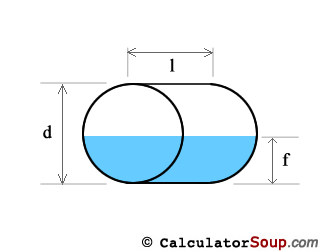
Calculator Use
Estimate the total and filled volumes of tanks such as oil tanks and water tanks. Assumes inside dimensions of the tank.
*Actual fill volumes will differ. Tank volume calculations are based on tank geometries shown below. These tank shapes are calculated assuming exact geometric solid shapes such as cylinders, circles and spheres. Actual water and oil tanks may not be perfect geometric shapes or might have other features not accounted for here so, these calculations should only be considered estimates.
Methods to calculate the volume of tanks and the volume of a liquid inside a tank.
These calculations will give you cubic measures such as ft3 or m3 depending on your units of measure.

Horizontal Cylinder Tank
Total volume of a cylinder shaped tank is the area, A, of the circular end times the length, l. A = πr2 where r is the radius which is equal to 1/2 the diameter or d/2. Therefore:
V(tank) = πr2l
The filled volume of a horizontal cylinder tank is calculated by first finding the area, A, of a circular segment and multiplying it by the length, l.
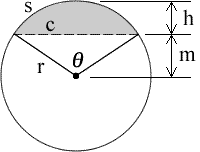 Area of the circular segment, the grey shaded area, is A = (1/2)r2(θ – sinθ) where θ = 2*arccos(m/r) and θ is in radians. Therefore, V(segment) = (1/2)r2(θ – sinθ)l. If the fill height f is less than 1/2 of d then we use the segment created from the filled height and V(fill) = V(segment). However, if the fill height f is greater than 1/2 of d then we use the segment that is created by the empty portion of the tank and subtract it from the total volume to get the filled volume; V(fill) = V(tank) – V(segment).
Area of the circular segment, the grey shaded area, is A = (1/2)r2(θ – sinθ) where θ = 2*arccos(m/r) and θ is in radians. Therefore, V(segment) = (1/2)r2(θ – sinθ)l. If the fill height f is less than 1/2 of d then we use the segment created from the filled height and V(fill) = V(segment). However, if the fill height f is greater than 1/2 of d then we use the segment that is created by the empty portion of the tank and subtract it from the total volume to get the filled volume; V(fill) = V(tank) – V(segment).
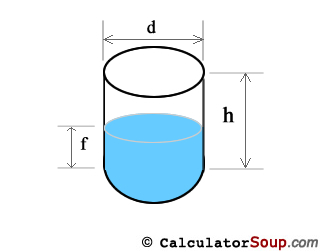
Vertical Cylinder Tank
Total volume of a cylinder shaped tank is the area, A, of the circular end times the height, h. A = πr2 where r is the radius which is equal to d/2. Therefore:
V(tank) = πr2h
The filled volume of a vertical cylinder tank is just a shorter cylinder with the same radius, r, and diameter, d, but height is now the fill height or f. Therefore:
V(fill) = πr2f
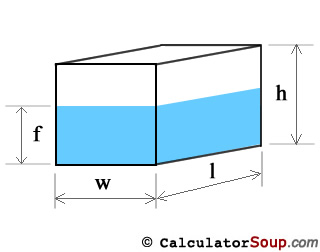
Rectangle Tank
Total volume of a rectangular prism shaped tank is length times width times height. Therefore,
V(tank) = lwh
The filled volume of a rectangular tank is just a shorter height with the same length and width. The new height is the fill height or f. Therefore:
V(fill) = lwf
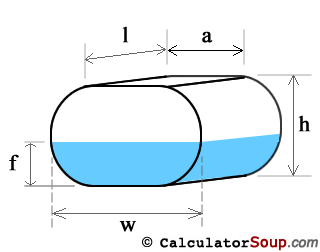
Horizontal Oval Tank
Volume of an oval tank is calculated by finding the area, A, of the end, which is the shape of a stadium, and multiplying it by the length, l. A = πr2 + 2ra and it can be proven that r = h/2 and a = w – h where w>h must always be true. Therefore:
V(tank) = (πr2 + 2ra)l
Volume of fill of a horizontal oval tank is best calculated if we assume it is 2 halves of a cylinder separated by a rectangular tank. We then calculate fill volume of 1) a Horizontal Cylinder Tank where l = l, f = f, and diameter d = h, and 2) a Rectangle Tank where l = l, f = f, and rectangle width w is a = w – h of the oval tank.
V(fill) = V(fill-horizontal-cylinder) + V(fill-rectangle)
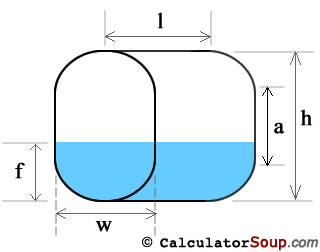
Vertical Oval Tank
Volume of an oval tank is calculated by finding the area, A, of the end, which is the shape of a stadium, and multiplying it by the length, l. A = πr2 + 2ra and it can be proven that r = w/2 and a = h – w where h>w must always be true. Therefore:
V(tank) = (πr2 + 2ra)h
Volume of fill of a vertical oval tank is best calculated if we assume it is 2 halves of a cylinder separated by a rectangular tank. With r = w/2 = hieght of the semicircle ends, we can define 3 general fill position areas.
- Fill, f < r
We calculate fill volume using the circular segment method, as in a Horizontal Cylinder Tank, for the filled portion. - Fill, f > r and f < (r+a)
The filled volume is exactly 1/2 of the cylinder portion plus the volume of fill inside the rectangular portion. - Fill, f > (r+a) and f < h
We calculate fill volume using the circular segment method, as in a Horizontal Cylinder Tank, for the empty portion. Volume will be V(tank) – V(segment).
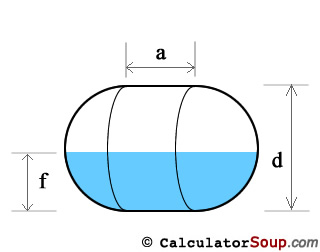
Horizontal Capsule Tank
We treat a capsule as a sphere of diameter d split in half and separated by a cylinder of diameter d and height a. Where r = d/2.
V(sphere) = (4/3)πr3, and
V(cylinder) = πr2a, therefore
V(capsule) = πr2((4/3)r + a)
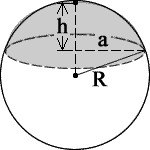 Volume of fill for a horizontal capsule is done by using the circular segment method for the Horizontal Cylinder and, with a similar approach, using calculations of a spherical cap for the sphere section of the tank where,
Volume of fill for a horizontal capsule is done by using the circular segment method for the Horizontal Cylinder and, with a similar approach, using calculations of a spherical cap for the sphere section of the tank where,
V(spherical cap) = (1/3)πh2(3R – h)
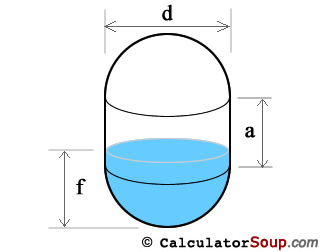
Vertical Capsule Tank
We treat a capsule as a sphere of diameter d split in half and separated by a cylinder of diameter d and height a. Where r = d/2 https://infofurmanner.de/.
V(capsule) = πr2((4/3)r + a)
Volume of fill for a vertical capsule is calculated in a fashion similar to the method used for the Vertical Oval Tank where r = d/2 = height of each hemisphere end.
- Fill, f < r
We calculate fill volume using the spherical cap method, for the filled portion. - Fill, f > r and f < (r+a)
The filled volume is exactly 1/2 of the sphere portion plus the volume of fill inside the vertical cylinder portion. - Fill, f > (r+a) and f < h
We calculate fill volume using the spherical cap method for the empty portion. Volume will be V(tank) – V(spherical cap).
1 British Brewers Barrel = 1BBL = 36 gallons = 288 pints = 163.6 litres = 43 US gallons
